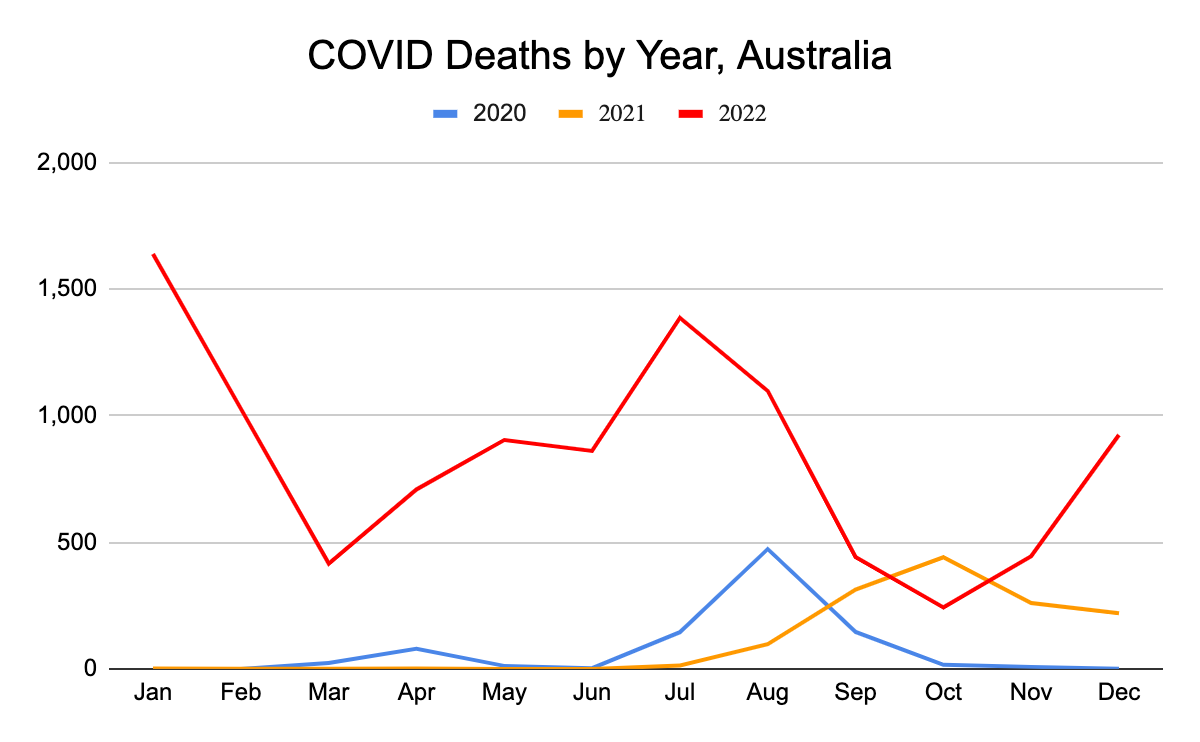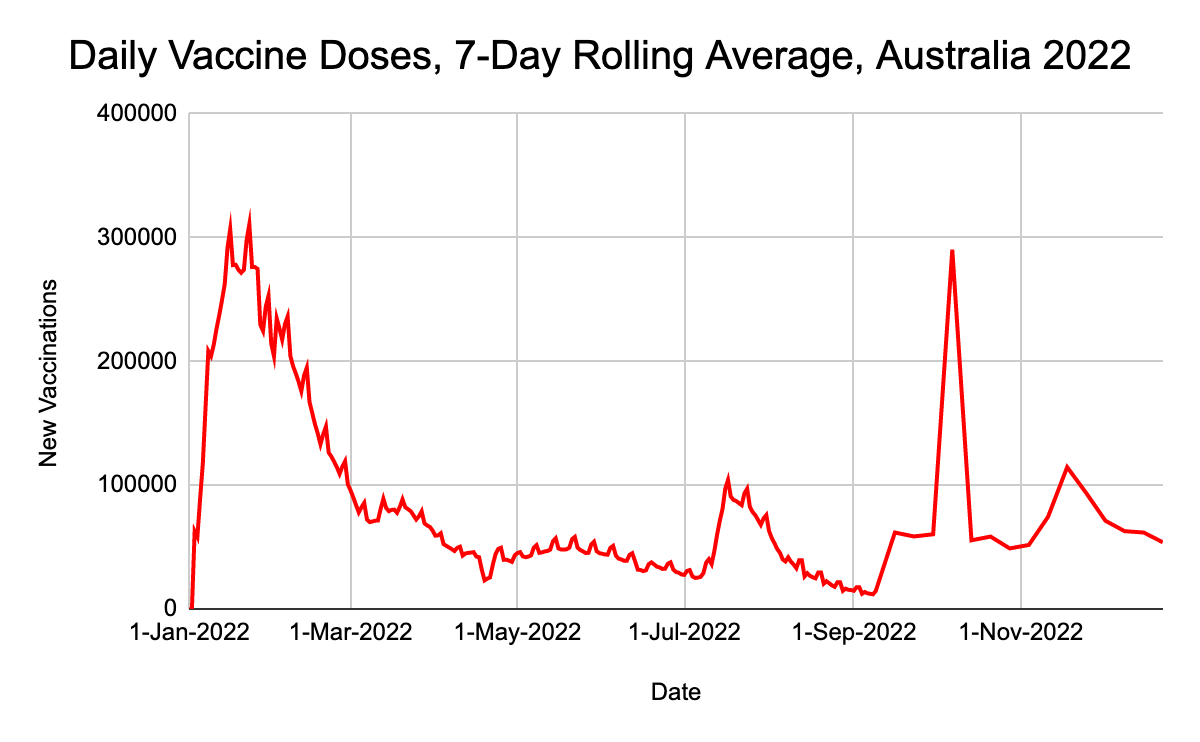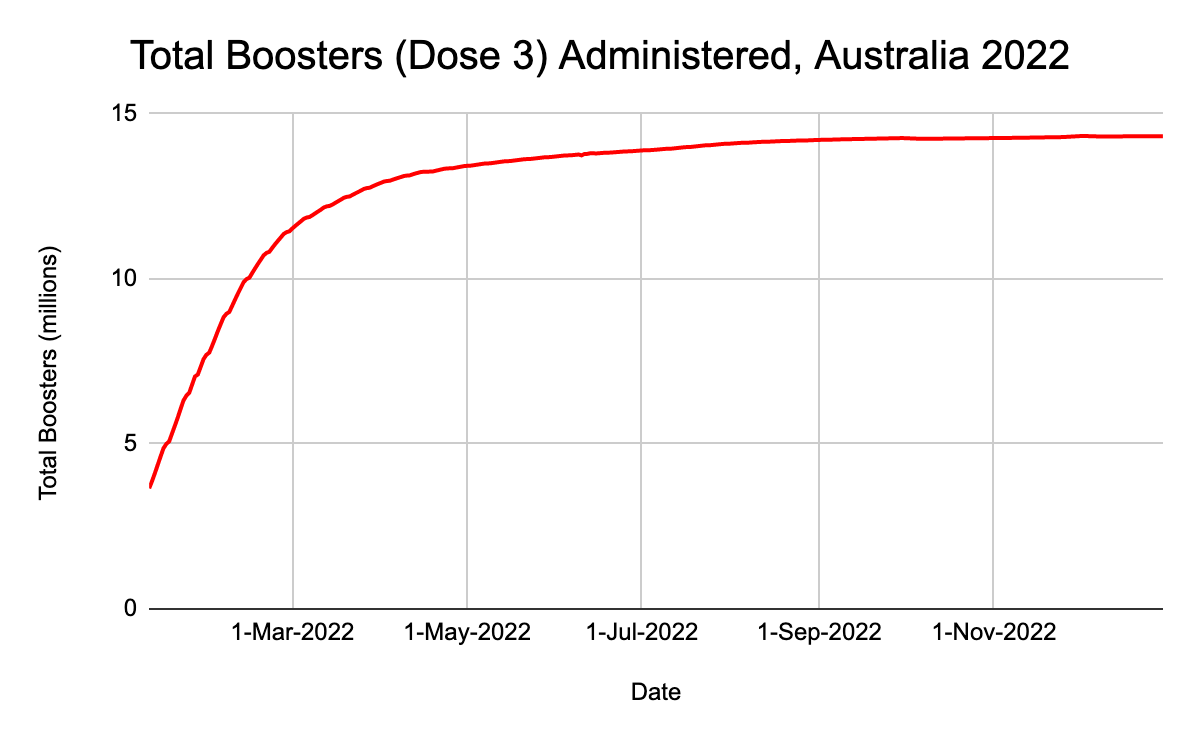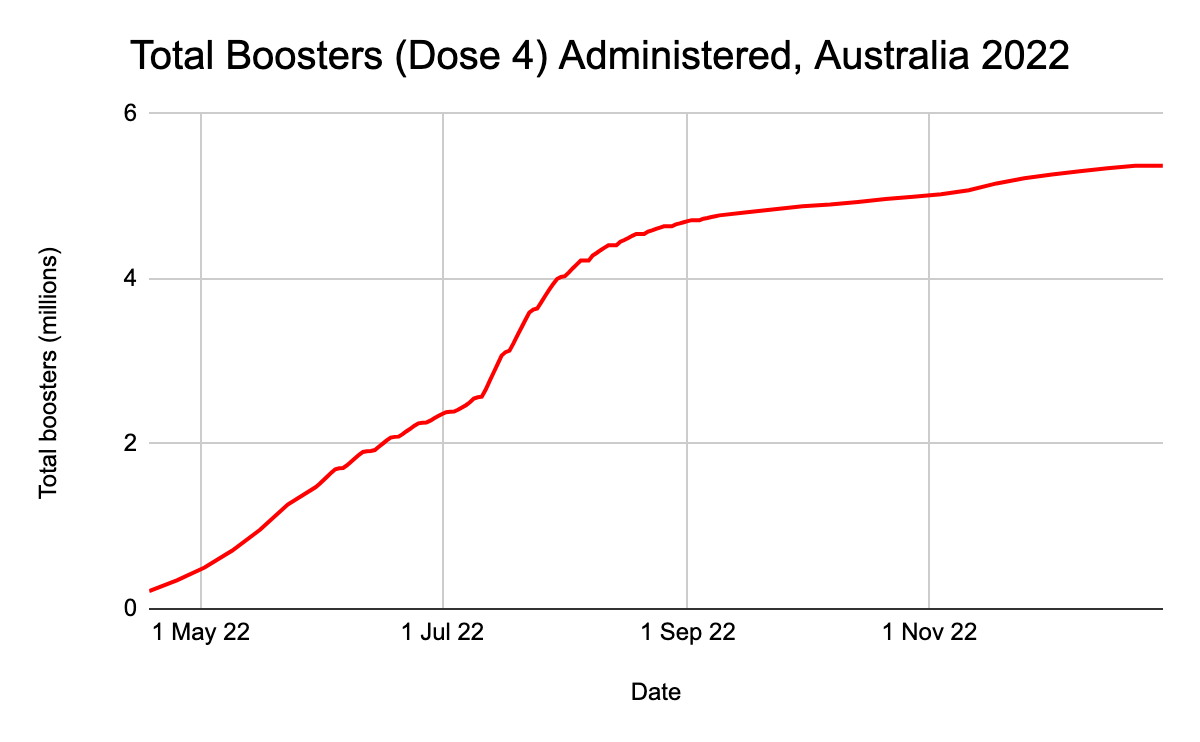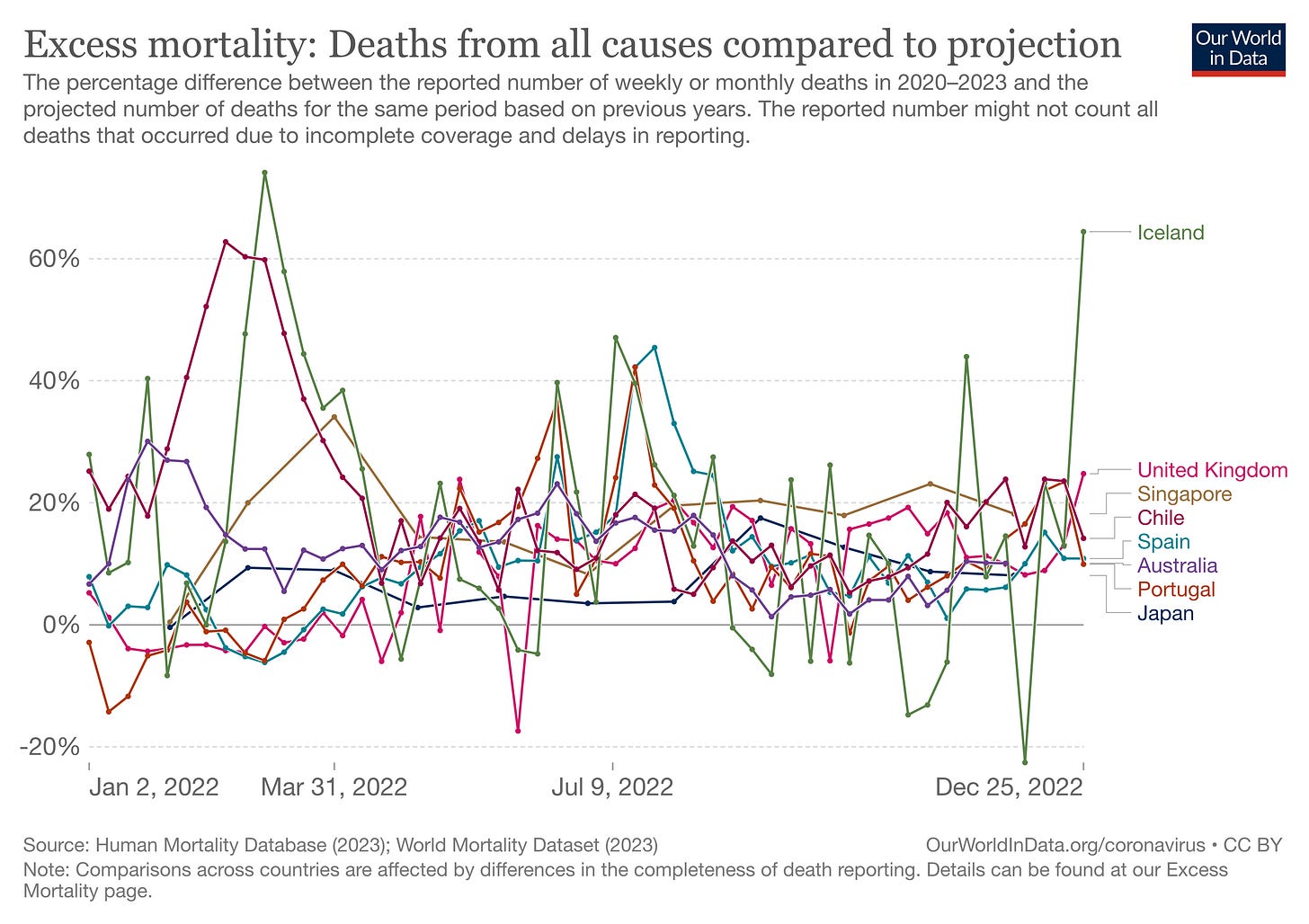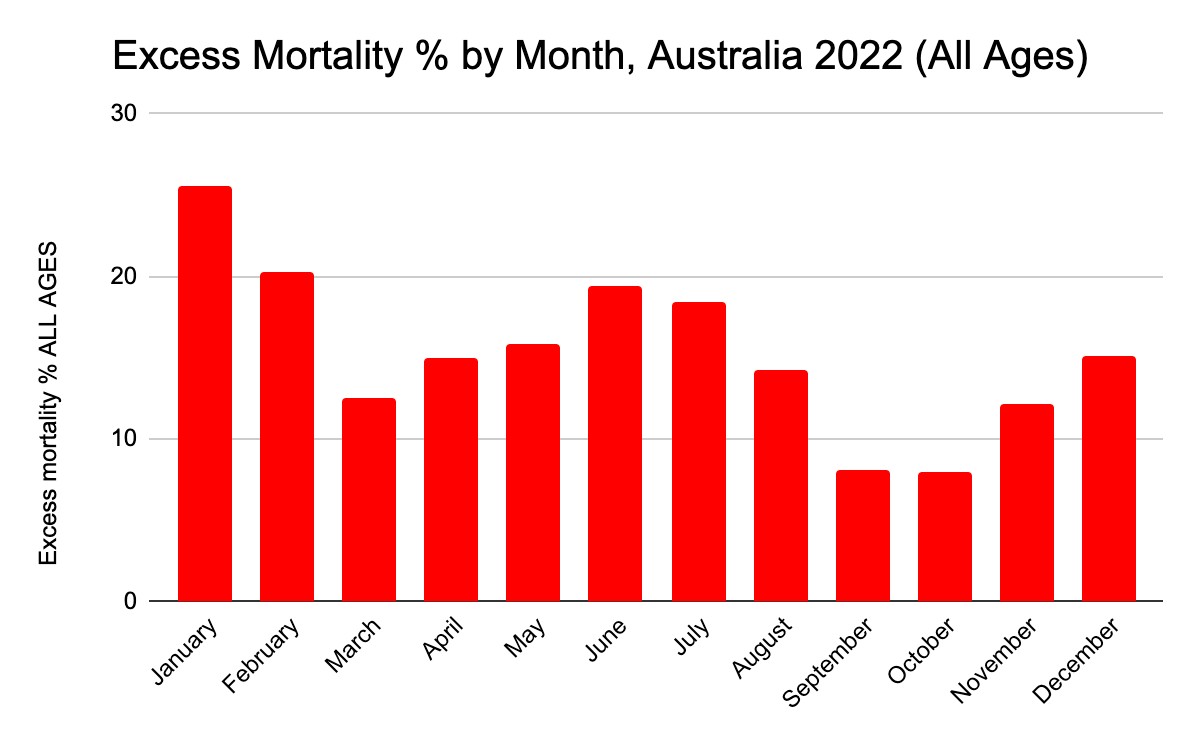Excess Mortality in Australia in 2022
Making sense of the pandemic years
Mortality in Australia in 2022 was exceptional.
In the year 2022, 190,394 people died in Australia, as reported by the Australian Bureau of Statistics (ABS) in its “Provisional Mortality Statistics, Jan - Dec 2022” release.1
The number of deaths represented an increase of approximately 15.4% by year’s end; or, in human terms: an extra 25,235 people dead in Australia in 2022.
Simply put, Australia experienced its largest excess mortality event since World War Two.
And it is likely the majority of Australians don’t even know about it.
Australia: punching above its weight in 2020-21; not so much in 2022
As far as COVID-19 deaths were concerned, Australia’s experience through the first two years of the pandemic was the envy of most nations.
Despite the prevalence of the more virulent Alpha and Delta variants, Australia’s cumulative death toll from COVID-19 during this period, was 2,257 deaths.
By comparison, in the period 1 January 2022 to 13 February 2022, Australia accumulated 2,167 COVID-19 deaths.2
So, in a six week period to commence 2022, Australia experienced more COVID-19 deaths than in the entire previous two years of the pandemic.
What went wrong?
Did COVID-19 deaths cause the excess mortality in 2022?
We know that COVID-19 deaths caused some of the excess mortality in 2022.
The contribution of COVID-19 deaths to excess mortality was significant in 2022 due to the January and July Omicron waves. Of the 25,235 excess deaths for 2022, 10,095 (40% of the excess deaths for 2022) were classified as deaths due to COVID-19.3
Classifying a COVID-19 death can, however, be murky at best.
ABS counts of COVID-19 deaths combine deaths “with” COVID-19 and “from” COVID-19. Each of Australia's 2022 COVID-19 deaths had, on average 3.1 other diseases and conditions certified as the causes of death, alongside the virus. A mere 4.4% of all COVID-19 deaths in 2022 had COVID-19 reported as the sole cause of death.4
Therefore, it is probable that the excess mortality figure attributable to COVID-19 in 2022 is overstated.
On the other hand, if COVID-19 deaths have been underestimated (as some have argued), it would seriously challenge the conventional thinking that vaccines effectively prevent severe illness and death caused by COVID-19.
Australia’s Omicron wave
In response to the first Omicron wave in Australia in late 2021, the Australian Technical Advisory Group on Immunisation (ATAGI) significantly escalated its vaccination policy.
The policy expanded eligibility criteria for booster vaccination and decreased the interval between booster doses and the primary course of vaccination.
The language justifying this change, however, was curiously vague:
“Strong evidence has accumulated over the past two weeks to indicate that booster doses of COVID-19 vaccines are likely to increase protection against infection with the Omicron variant…” [emphasis added]
“An earlier booster dose is expected to reduce the risk of symptomatic infection, severe illness and death from COVID-19. In combination with enhanced public health and social measures, it is also expected to mitigate the impacts of COVID-19 on the health system and its the broader impacts on the community…” [emphasis added]
“Strong evidence suggests that booster doses of COVID-19 vaccines may enhance protection against symptomatic disease due to the Omicron variant…” [emphasis added]5
The “strong” evidence base for the updated guidance (as described in the statement), consisted of a small selection of health sciences preprints; meaning they had not yet undergone formal peer review and should have been considered preliminary until published in a peer-reviewed journal.6
Unsurprisingly, therefore, the language was vague because it was based on predictions and modelling of the presumed effectiveness of vaccine boosters.
Hardly compelling reasons to get your booster.
Nevertheless, Australians embraced the message, rolled up their sleeves and got their new shots in January 2022 in record numbers:7
The shifting Paradigm
ATAGI is now advising that boosters are not recommended except for the most high-risk people in 2023.8
ATAGI’s changed guidance aligns with the World Health Organisations’s Strategic Advisory Group of Experts on Immunisation (SAGE), who, in their 28 March 2023 statement, also called for scaling back COVID-19 booster vaccinations for the majority of all but high-risk groups. In its statement, SAGE also noted:
The lack of cost-effectiveness for COVID-19 vaccination of healthy people;
The inconsistent evidence pointing to the reduction of post-COVID conditions from COVID-19 vaccination; and,
The widespread immunity from previous infection/vaccination (or both) for the majority of the population.9
The stance marks a considerable change from what was advised in 2021-22 regarding boosters.
What could possibly explain this shift?
Could the unprecedented global rates of excess mortality in other highly COVID-19 vaccinated countries of the world be a contributing factor?
Excess mortality not only soared in Australia in 2022, it also did in all the most highly COVID-19 vaccinated countries of the world too:
In Australia, the evidence shows a temporal association between increases in excess mortality corresponding with increases in the rates of COVID-19 vaccination (especially booster vaccination). For example, in January, when ATAGI escalated the booster vaccination guidance, excess mortality reached 26% for the month of January and 20% for February 2022. Similarly, when a “winter dose” (fourth booster) was approved in July 2022, excess mortality reached 18%:
Further questions
Australia is experiencing a crisis in excess mortality that commenced in 2022.
The causes of this excess mortality remain unknown, and questions remain:
If COVID-19 deaths accounted for 40% of Australia’s excess mortality in 2022, what explains the other 60% of Australia's excess mortality? Who were these people and why did they die?
If the COVID-19 deaths were so substantially larger in 2022, why didn’t we panic about “flattening the curve” like we did in 2020?
If the COVID-19 deaths were so substantially larger in 2022, why didn’t we lockdown again? If we didn’t because we recognised that lockdowns had calamitous health, economic and social impacts, then where’s the reckoning and who has been held accountable?
Why were people still dying of COVID-19 in 2022 and why are they still dying of COVID-19 today?
If COVID-19 deaths have been underestimated in 2022, should the COVID-19 vaccines still be considered “safe and effective”? Do the benefits still far outweigh the risks? To what extent have they prevented severe illness and death? Are we to believe that the excess mortality figure would have been far worse were it not for the miracle vaccines?
There is seemingly a growing acknowledgement that the relentless propaganda about the benefits of vaccination, coupled with the widespread censorship of the serious risks of vaccination, cannot be sustained much longer.
The Paradigm is shifting.
Excess mortality would appear even greater in 2022 if 2020 was included in the “baseline average” against which 2022 deaths are compared. The ABS excludes 2020 from the baseline average on the basis of “prolonged periods where deaths were significantly lower than expected” which could “artificially indicate higher than expected mortality in the years following.
Acknowledging that preprints allow the scientific community to disseminate their findings more quickly which is particularly important during a pandemic. The point here is that using these preprints to guide public health policy might be problematic, as the observational evidence for Australia’s excess mortality in 2022 potentially shows.
The outlier shown in the “Vaccines Administered, Australia 2022” 7 October 2022, where an additional 290,293 vaccinations were adminstered in the week prior, is unexplained and is likely a readjustment of an earlier miscount.


